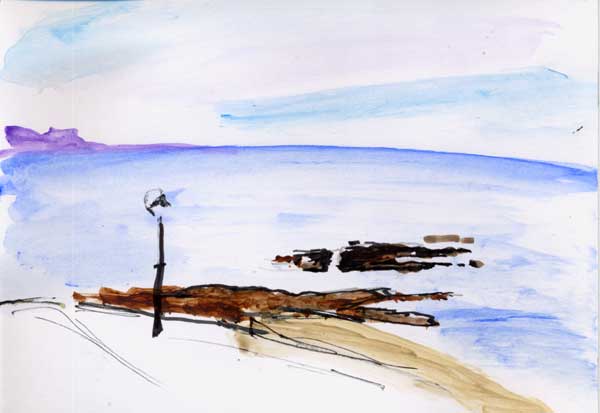|
Long combers — breaking waves — can often be seen rolling in toward the far eastern corner of Lyme. They look as if they might be rolling over a drowned city. And they are.
As the tide lowers, a platform of rock is revealed; dark, seaweedy, wrinkled, crackled by channels into several masses. These rocks, stretching outward a hundred yards or more, are the vestige of a former piece of land, planed away by the sea.
It was a piece of the town. According to old accounts, there were at least thirty-five houses out there. Even after the houses were swept away by storms, townspeople used the place as a quarry, removing quantities of rock. Not wise: they were speeding the destruction of their own defences, helping the sea to rush closer in and begin its attack on the cliffs under the town.
The main mass of these intertidal rocks is called Broad Ledge. It is a ragged area extending roughly north to south, but the joints in it — geological cracks that show up as ditches of water when the tide is at the right level — make a regular network lying diagonally across it, splitting it into blocks almost like a pavement. The main set of these fissures runs southwest, one being especially long and continuous and dividing Broad Ledge into two islands offset from each other.
In the other set of fissures, perpendicular to the first, there is one prominent trench across the centre, positioned so that from the land corner you can take a sightline along it, appearing wide and foreshortened and remarkably straight, like a miniature rift valley, southeast toward Portland Bill and Paris. This not a natural trench but a dug one, which, before the construction of the sewage “castle” in the 1990s, carried the an outlet pipe as far out from the town as possible.

Another channel, wider and deeper and more irregular, divides Broad Ledge from a western strip (nearer to the town) called Long Ledge, so that in plan the whole thing looks like a crab's left claw.
As the tide comes in, white water begins to be seen far out. That outer part of Broad Ledge will be the first to break the surface as an island, showing that it must slope slightly up. As the tide continues to rise, the rock platform is covered by a gradually thinner sheet of water, through which the waves crawl, breaking for more of the way. Thus is created the grand sight of the train of combers, which can be watched from nearby or from farther viewpoints such as the Bell Cliff. It differs for every state of the tide, that is, every depth of water. Each wave breaks, at first, only over the ledges; the miles of it to left and right are still too far offshore to break. Therefore the white folded-over foam-front remains at about a constant width (in contrast to typical shore waves, in which the breaking unrolls progressively along the wave's length). Each comber runs inshore like this, for a hundred yards or more, a short and sometimes strikingly high white wall. It looks as if surfers could ride it the whole way; but this would be dangerous because it would have to be done only when the rocks are far enough below. The traveling wall may be divided into two or more shorter walls, depending on the water's depth and hence the depths to the channels among the rocks. Often two or three or four of these inward-running white walls are observable at a time; each may leave a trail of foam stretching behind it to the foot of the next in-rolling breaker, so that the whole forms a long white field lying before the rest of the bay and the distant cliffs.
You wonder about the view from beneath, the scenery within the layer of water: the undersides of these traveling combers, the seaweed and little animals on the rocks, wrested about but accustomed to it.
As the tide subsides further, it creates a scene even more beautiful and subtle, best viewed from the headland above: low wave fronts, angled to various directions, intersect with each other in the shallow sheet, like folds in the skin of a rhinoceros.
Then the expanse of the rocks emerges, still an island or island-group until the tide is at its lowest. Often it seems to cause still water around itself, which shows as a glassy pale surround separating the rocks from the rippled mass of the sea.
Meanwhile, close in under the concrete viewpoint of the shore, a level pavement of rock has been revealed, divided by a grid of cracks as if made of huge tiles; boulders lie on it in stages of their roll toward the sea; and there are areas of hard sand with shining wrinkles left by the last ebbing ripples. Birds, including sometimes cormorants, stand sentinel on the rocks.
A buoy many hundred yards out, with a blinking light scarcely noticeable except at night, shows that there are other shallow areas over rocks that do not appear above the water. They are the remains of land that succumbed to the encroaching sea more centuries or millennia ago.
Back
|
